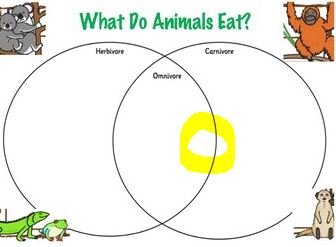It’s a great debate, and it’s very easy to be convinced one way or the other.
The purpose of this article is to provide an unbiased standpoint based on scientific fact. But before we have any hope of reaching an answer, we need to realise the question is wrong.
What we’re really discussing is – Where on the scale of Obligate Herbivore to Obligate Carnivore is a Dog?
For want of a better starting point, I’ll offer a presumption (of which you’re more than welcome to refute).
Below, highlighted with a yellow circle, is where I believe a dog lies on the herbivore to carnivore scale:
The yellow circle is well within the carnivore circle, but also within the omnivore intersection.
The presumption is based on the following:
- A dog has descended from the wolf, and wolves are definitely on the carnivore side of the scale.
- My dog loves carrots, so he might be somewhere within the “omnivore” intersection.
- If I put a plate of carrots at one side of my kitchen, a plate of meat at the other side, and my dog in the middle, I am 99% confident which plate he’ll go to first.
That’s neither here nor there, so let’s discuss two scientific perspectives. Firstly, I’ll discuss what we know about the anatomy of a dog compared to a cat as an obligate carnivore, and a human as an omnivore (or at least more omnivorous than a dog). Secondly I’ll skirt over what we know about amino profiles and bioavailability of meat and plant-based proteins.
Digestive tract and Coefficient of Fermentation
Cats.
Most cats, unless they’re really hungry or really weird cats, will sniff a vegetable and give you a “What the fluffballs is that? look before stomping off on the hunt for mice.
We know a cat is an obligate carnivore based on a number of tell-tale factors (ancestry, dental structure, anatomy). They have a short digestive tract, which means they are unable to sufficiently process plant matter, vegetables, or carbohydrates. Meats and animal fats are absorbed by the digestive system much more readily.
Humans.
Our digestive tract is longer, which means our digestive system is able to absorb more nutrients from plants and sustain a healthy existence.
Dogs.
Dogs are between cats and humans, which is the reason we have come to feed domestic dogs foods which are plant-based more than meat-based. Their digestive tract is longer than a cats. Also, as scavengers they will often eat whatever they find available.
I’ll take a little sidestep here and discuss commercial dog (and cat) foods. Most will be advertised as meat (Chicken, Beef, Lamb, and so forth), but in reality will be significantly more plant or carbohydrate based. The reason for this isn’t nutrition, it’s driven by economics. Meat is a much more expensive ingredient, so in order for a pet food manufacturer to expand their profit margin they will substitute meat with cheaper ingredients. Take a look at the ingredients of many supermarket cat foods. You’ll be surprised to see most are filled with grain despite a cat being an obligate carnivore. It’s nonsensical from a nutritional perspective.
Recent studies by Dr. Wouter Hendriks of Utrect University in the Netherlands further suggest a canine leans more to the carnivore side of the scale than we had previously believed. His studies have shown a dog’s digestive tract may be longer than a cats, but it’s also narrower. This introduces the concept “Coefficient of Fermentation”, where the volume of a dog’s digestive tract is actually very similar to that of a cat.
Amino Acids and Bioavailability
Protein is fundamental to health. You, me, and our pets all need protein to survive. Many foodstuffs contain protein, but it’s not as simple as that. It’s more about the building blocks of protein, and these are called amino acids. Plant proteins are different to meat proteins because they contain different amino acid profiles.
So why is this important?
Amino acids fall into two categories – essential, and non-essential. We must consume essential amino acids from our diet. Non-essential amino acids we can actually produce ourselves. Cats require more essential amino acids in their diet than we do, one of which being taurine. Dogs also depend on more essential amino acids than we do.
Meat provides a dog with all essential amino acids. This is a very important consideration when feeding a dog, as not feeding meat means your dog *may* not get all essential amino acids from his (or her) diet.
Bioavailability of amino acids is also a critical factor, and is gauged as a percentage. Meat (eggs, and dairy) proteins are generally more bioavailable than plant proteins, so meat protein could be 90% bioavailable compared to protein from a vegetable at 50%. This ties in with the length of digestive tract we spoke of earlier.
To summarise the last few paragraphs, we know meat contains all essential amino acids a dog requires, whereas a plant diet *may* not. We also know meat proteins are generally more bioavailable, and this is important considering a dog has a shorter (and thinner) digestive tract than a typical omnivore. What remains open to interpretation is whether a combination of plant ingredients with varying amino acid profiles and bioavailability can be a sufficient alternative to meat.
Further reading:
https://www.vetstreet.com/our-pet-experts/are-dogs-carnivores-heres-what-new-research-says
https://www.petfoodreviews.com.au/are-dogs-carnivores-or-omnivores/

